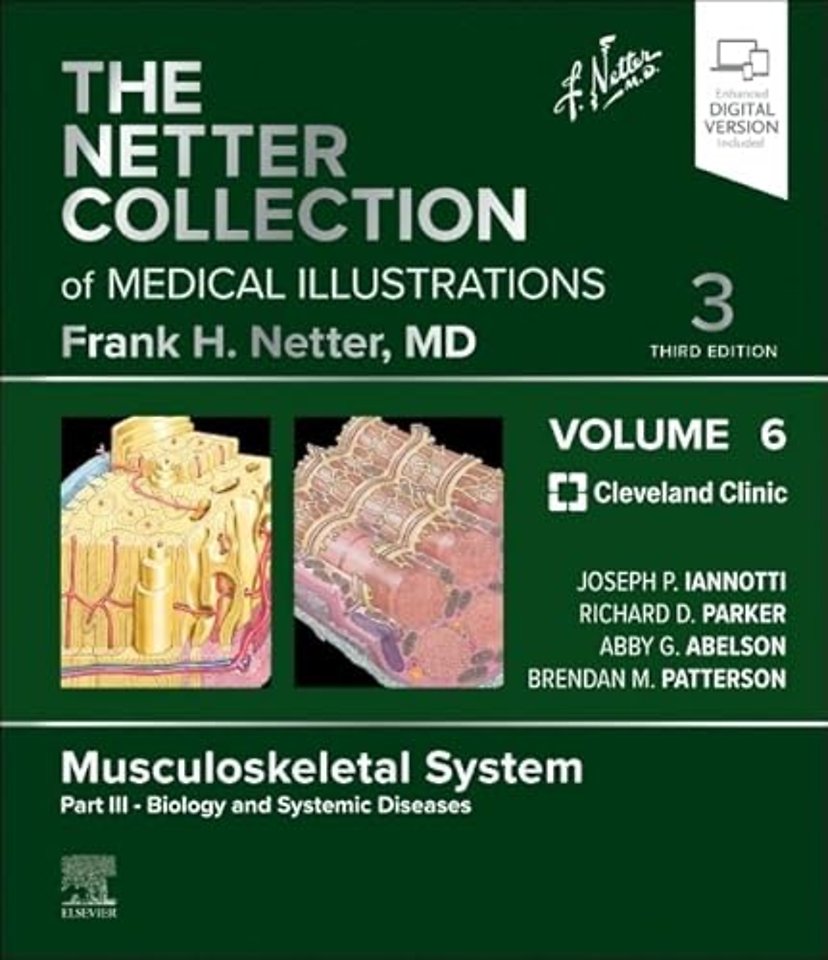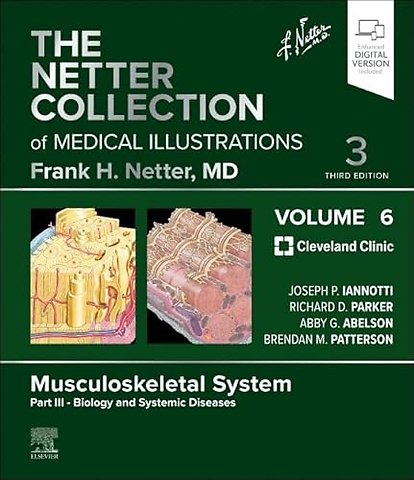SECTION 1 EMBRYOLOGY<br>1.1 Amphioxus and Human Embryo at 16 Days<br>1.2 Differentiation of Somites into Myotomes, Sclerotomes, and Dermatomes<br>1.3 Progressive Stages in Formation of Vertebral Column, Dermatomes, and Myotomes; Mesenchymal Precartilage Primordia of Axial and Appendicular Skeletons at 5 Weeks<br>1.4 Fate of Body, Costal Process, and Neural Arch Components of Vertebral Column, with Sites and Time of Appearance of Ossification Centers<br>1.5 First and Second Cervical Vertebrae at Birth; Development of Sternum<br>1.6 Early Development of Skull<br>1.7 Skeleton of Full-Term Newborn<br>1.8 Changes in Position of Limbs Before Birth; Precartilage Mesenchymal Cell Concentrations of Appendicular Skeleton at 6 Weeks<br>1.9 Changes in Ventral Dermatome Pattern During Limb Development<br>1.10 Initial Bone Formation in Mesenchyme; Early Stages of Flat Bone Formation<br>1.11 Secondary Osteon (Haversian System)<br>1.12 Growth and Ossification of Long Bones<br>1.13 Growth in Width of a Bone and Osteon Remodeling<br>1.14 Remodeling: Maintenance of Basic Form and Proportions of Bone during Growth<br>1.15 Development of Three Types of Synovial Joints<br>1.16 Segmental Distribution of Myotomes in Fetus of 6 Weeks; Developing Skeletal Muscles at 8 Weeks<br>1.17 Development of Skeletal Muscle Fibers<br>1.18 Cross Sections of Body at 6 to 7 Weeks<br>1.19 Prenatal Development of Perineal Musculature<br>1.20 Origins and Innervations of Pharyngeal Arch and Somite Myotome Muscles<br>1.21 Branchiomeric and Adjacent Myotomic Muscles at Birth<br><br>SECTION 2 PHYSIOLOGY<br>2.1 Microscopic Appearance of Skeletal Muscle Fibers<br>2.2 Organization of Skeletal Muscle<br>2.3 Intrinsic Blood and Nerve Supply of Skeletal Muscle<br>2.4 Composition and Structure of Myofilaments<br>2.5 Muscle Contraction and Relaxation<br>2.6 Biochemical Mechanics of Muscle Contraction<br>2.7 Sarcoplasmic Reticulum and Initiation of Muscle Contraction<br>2.8 Initiation of Muscle Contraction by Electric Impulse and Calcium Movement<br>2.9 Motor Unit<br>2.10 Structure of Neuromuscular Junction<br>2.11 Physiology of Neuromuscular Junction<br>2.12 Pharmacology of Neuromuscular Transmission<br>2.13 Physiology of Muscle Contraction<br>2.14 Energy Metabolism of Muscle<br>2.15 Muscle Fiber Types<br>2.16 Growth Plate: Structure, Physiology, and Pathophysiology<br>2.17 Growth Plate: Structure, Physiology, and Pathophysiology (Continued)<br>2.18 Growth Plate: Structure and Blood Supply<br>2.19 Growth Plate: Peripheral Fibrocartilaginous Element<br>2.20 Composition and Structure of Cartilage<br>2.21 Bone Cells and Bone Deposition<br>2.22 Composition of Bone<br>2.23 Structure of Cortical (Compact) Bone<br>2.24 Structure of Trabecular Bone<br>2.25 Formation and Composition of Collagen<br>2.26 Formation and Composition of Proteoglycan<br>2.27 Structure and Function of Synovial Membrane<br>2.28 Histology of Connective Tissue<br>2.29 Bone Homeostasis: Dynamics<br>2.30 Bone Homeostasis: Regulation of Calcium and Phosphate Metabolism<br>2.31 Effects of Bone Formation and Bone Resorption on Skeletal Mass<br>2.32 Four Mechanisms of Bone Mass Regulation<br>2.33 Normal Calcium and Phosphate Metabolism<br>2.34 Nutritional Calcium Deficiency<br>2.35 Effects of Disuse and Stress (Weight Bearing) on Bone Mass<br>2.36 Musculoskeletal Effects of Weightlessness (Space Flight)<br>2.37 Bone Architecture and Remodeling in Relation to Stress<br>2.38 Stress-Generated Electric Potentials in Bone<br>2.39 Bioelectric Potentials in Bone<br>2.40 Age-Related Changes in Bone Geometry<br>2.41 Age-Related Changes in Bone Geometry (Continued)<br><br>SECTION 3 METABOLIC DISEASES<br>3.1 Parathyroid Hormone<br>3.2 Primary Hyperparathyroidism: Pathophysiology<br>3.3 Primary Hyperparathyroidism: Clinical Manifestations<br>3.4 Differential Diagnosis of Hypercalcemic States<br>3.5 Hypoparathyroidism: Pathologic Physiology<br>3.6 Chronic Hypoparathyroidism: Clinical Manifestations<br>3.7 Hypocalcemia: Clinical Manifestations<br>3.8 Pseudohypoparathyroidism<br>3.9 Mechanism of Parathyroid Hormone Activity on End Organ<br>3.10 Mechanism of Parathyroid Hormone Activity on End Organ: Cyclic AMP Response to PTH<br>3.11 Clinical Guide to Parathyroid Hormone Assay<br>3.12 Clinical Guide to Parathyroid Hormone Assay (Continued)<br>3.13 Childhood Rickets<br>3.14 Adult Osteomalacia<br>3.15 Nutritional Deficiency: Rickets and Osteomalacia<br>3.16 Vitamin D–Resistant Rickets and Osteomalacia Due to Proximal Renal Tubular Defects (Hypophosphatemic Rachitic Syndromes)<br>3.17 Vitamin D–Resistant Rickets and Osteomalacia Due to Proximal and Distal Renal Tubular Defects<br>3.18 Vitamin D–Dependent (Pseudodeficiency) Rickets and Osteomalacia<br>3.19 Vitamin D–Resistant Rickets and Osteomalacia Due to Renal Tubular Acidosis<br>3.20 Metabolic Aberrations of Renal Osteodystrophy<br>3.21 Rickets, Osteomalacia, and Renal Osteodystrophy<br>3.22 Bony Manifestations of Renal Osteodystrophy<br>3.23 Vascular and Soft Tissue Calcification in Secondary Hyperparathyroidism of Chronic Renal Disease<br>3.24 Clinical Guide to Vitamin D Measurement<br>3.25 Hypophosphatasia<br>3.26 Osteoporosis: Risk Factors<br>3.27 Osteoporosis: Involutional<br>3.28 Osteoporosis: Clinical Manifestations<br>3.29 Osteoporosis: Progressive Spinal Deformity<br>3.30 Radiology of Osteopenia: Classification<br>3.31 Radiology of Osteopenia: Imaging<br>3.32 Radiology of Osteopenia: DXA<br>3.33 Transiliac Bone Biopsy<br>3.34 Treatment of Complications of Spinal Osteoporosis<br>3.35 Treatment of Osteoporosis: Medications<br>3.36 Treatment of Osteoporosis: Functional Domains of Bisphosphonate Chemical Structure<br>3.37 Treatment of Osteoporosis: Inhibition of FPP Synthase<br>3.38 Osteogenesis Imperfecta Type I<br>3.39 Osteogenesis Imperfecta Type III<br>3.40 Marfan Syndrome<br>3.41 Marfan Syndrome (Continued)<br>3.42 Ehlers-Danlos Syndromes<br>3.43 Ehlers-Danlos Syndromes (Continued)<br>3.44 Osteopetrosis (Albers-Schönberg Disease)<br>3.45 Paget Disease of Bone<br>3.46 Paget Disease of Bone (Continued)<br>3.47 Pathophysiology and Treatment of Paget Disease of Bone<br>3.48 Fibrodysplasia Ossificans Progressiva<br><br>SECTION 4 CONGENITAL AND DEVELOPMENTAL DISORDERS<br>Dwarfism<br>4.1 Achondroplasia: Clinical Manifestations<br>4.2 Achondroplasia: Clinical Manifestations (Continued)<br>4.3 Achondroplasia: Clinical Manifestations of Spine<br>4.4 Achondroplasia: Diagnostic Testing<br>4.5 Hypochondroplasia<br>4.6 Diastrophic Dwarfism<br>4.7 Pseudoachondroplasia<br>4.8 Metaphyseal Chondrodysplasia, McKusick Type<br>4.9 Metaphyseal Chondrodysplasia, Schmid Type<br>4.10 Chondrodysplasia Punctata<br>4.11 Chondroectodermal Dysplasia (Ellis-van Creveld Syndrome), Grebe Chondrodysplasia, and Acromesomelic Dysplasia<br>4.12 Multiple Epiphyseal Dysplasia, Fairbank Type<br>4.13 Pycnodysostosis (Pyknodysostosis)<br>4.14 Camptomelic (Campomelic) Dysplasia<br>4.15 Spondyloepiphyseal Dysplasia Tarda and Spondyloepiphyseal Dysplasia Congenita<br>4.16 Spondylocostal Dysostosis and Dyggve-MelchiorClausen Dysplasia<br>4.17 Kniest Dysplasia<br>4.18 Mucopolysaccharidoses<br>4.19 Principles of Treatment of Skeletal Dysplasias<br>Neurofibromatosis<br>4.20 Diagnostic Criteria and Cutaneous Lesions in Neurofibromatosis<br>4.21 Cutaneous Lesions in Neurofibromatosis<br>4.22 Spinal Deformities in Neurofibromatosis<br>4.23 Bone Overgrowth and Erosion in Neurofibromatosis<br>Other<br>4.24 Arthrogryposis Multiplex Congenita<br>4.25 Fibrodysplasia Ossificans Progressiva and Progressive Diaphyseal Dysplasia<br>4.26 Osteopetrosis and Osteopoikilosis<br>4.27 Melorheostosis<br>4.28 Congenital Elevation of Scapula, Absence of Clavicle, and Pseudarthrosis of Clavicle<br>4.29 Madelung Deformity<br>4.30 Congenital Bowing of the Tibia<br>4.31 Congenital Pseudoarthrosis of the Tibia and Dislocation of the Knee<br>Leg-Length Discrepancy<br>4.32 Clinical Manifestations<br>4.33 Evaluation of Leg-Length Discrepancy<br>4.34 Charts for Timing Growth Arrest and Determining Amount of Limb Lengthening to Achieve Limb-Length Equality at Maturity<br>4.35 Growth Arrest<br>4.36 Ilizarov and De Bastiani Techniques for Limb Lengthening<br>Congenital Limb Malformation<br>4.37 Growth Factors<br>4.38 Foot Prehensility in Amelia<br>4.39 Failure of Formation of Parts: Transverse Arrest<br>4.40 Failure of Formation of Parts: Transverse Arrest (Continued)<br>4.41 Failure of Formation of Parts: Transverse Arrest (Continued)<br>4.42 Failure of Formation of Parts: Transverse Arrest (Continued)<br>4.43 Failure of Formation of Parts: Transverse Arrest (Continued)<br>4.44 Failure of Formation of Parts: Transverse Arrest (Continued)<br>4.45 Failure of Formation of Parts: Transverse Arrest (Continued)<br>4.46 Failure of Formation of Parts: Longitudinal Arrest<br>4.47 Failure of Formation of Parts: Longitudinal Arrest (Continued)<br>4.48 Failure of Formation of Parts: Longitudinal Arrest (Continued)<br>4.49 Failure of Formation of Parts: Longitudinal Arrest (Continued)<br>4.50 Duplication of Parts, Overgrowth, and Congenital Constriction Band Syndrome<br><br>SECTION 5 RHEUMATIC DISEASES<br>Rheumatic Diseases<br>5.1 Joint Pathology in Rheumatoid Arthritis<br>5.2 Early and Moderate Hand Involvement in Rheumatoid Arthritis<br>5.3 Advanced Hand Involvement in Rheumatoid Arthritis<br>5.4 Foot Involvement in Rheumatoid Arthritis<br>5.5 Knee, Shoulder, and Hip Joint Involvement in Rheumatoid Arthritis<br>5.6 Extraarticular Manifestations in Rheumatoid Arthritis<br>5.7 Extraarticular Manifestations in Rheumatoid Arthritis (Continued)<br>5.8 Immunologic Features in Rheumatoid Arthritis<br>5.9 Variable Clinical Course of Adult Rheumatoid Arthritis<br>Treatment of Rheumatoid Arthritis<br>5.10 Exercises for Upper Extremities<br>5.11 Exercises for Shoulders and Lower Extremities<br>5.12 Surgical Management in Rheumatoid Arthritis<br>Synovial Fluid Examination<br>5.13 Techniques for Aspiration of Joint Fluid<br>5.14 Synovial Fluid Examination<br>5.15 Synovial Fluid Examination (Continued)<br>Juvenile Arthritis<br>5.16 Systemic Juvenile Arthritis<br>5.17 Systemic Juvenile Arthritis (Continued)<br>5.18 Hand Involvement in Juvenile Arthritis<br>5.19 Lower Limb Involvement in Juvenile Arthritis<br>5.20 Ocular Manifestations in Juvenile Arthritis<br>5.21 Sequelae of Juvenile Arthritis<br>Osteoarthritis<br>5.22 Distribution of Joint Involvement in Osteoarthritis<br>5.23 Clinical Findings in Osteoarthritis<br>5.24 Clinical Findings in Osteoarthritis (Continued)<br>5.25 Hand Involvement in Osteoarthritis<br>5.26 Hip Joint Involvement in Osteoarthritis<br>5.27 Degenerative Changes<br>5.28 Spine Involvement in Osteoarthritis<br>Other<br>5.29 Ankylosing Spondylitis<br>5.30 Ankylosing Spondylitis (Continued)<br>5.31 Degenerative Changes in the Cervical Vertebrae<br>5.32 Psoriatic Arthritis<br>5.33 Psoriatic Arthritis (Continued)<br>5.34 Reactive Arthritis (formerly Reiter Syndrome)<br>5.35 Infectious Arthritis<br>5.36 Tuberculous Arthritis<br>5.37 Hemophilic Arthritis<br>5.38 Neuropathic Joint Disease<br>5.39 Gout and Gouty Arthritis<br>5.40 Tophaceous Gout<br>5.41 Calcium Pyrophosphate Deposition Disease (Pseudogout)<br>5.42 Nonarticular Rheumatism<br>5.43 Clinical Manifestations of Polymyalgia Rheumatica and Giant Cell Arteritis<br>5.44 Imaging of Polymyalgia Rheumatica and Giant Cell Arteritis<br>5.45 Fibromyalgia<br>5.46 Pathophysiology of Autoinflammatory Syndromes<br>5.47 Cutaneous Findings in Autoinflammatory Syndromes<br>5.48 Joint and Central Nervous System Findings in Autoinflammatory Syndromes<br>5.49 Vasculitis: Vessel Distribution<br>5.50 Vasculitis: Clinical and Histologic Features of Granulomatosis with Polyangiitis<br>5.51 Key Clinical Features of Primary Vasculitic Diseases<br>5.52 Renal Lesions in Systemic Lupus Erythematosus<br>5.53 Cutaneous Lupus Band Test<br>5.54 Lupus Erythematosus of the Heart<br>5.55 Antiphospholipid Syndrome<br>5.56 Scleroderma: Clinical Manifestations<br>5.57 Scleroderma: Clinical Findings<br>5.58 Scleroderma: Radiographic Findings of Acro-osteolysis and Calcinosis Cutis<br>5.59 Polymyositis and Dermatomyositis<br>5.60 Polymyositis and Dermatomyositis (Continued)<br>5.61 Primary Angiitis of the Central Nervous System<br>5.62 Behçet Syndrome: Triad<br>5.63 Behçet Syndrome: Positive Pathergy Test<br><br>SECTION 6 TUMORS OF MUSCULOSKELETAL SYSTEM<br>6.1 Initial Evaluation and Staging of Musculoskeletal Tumors<br>Benign Tumors of Bone<br>6.2 Osteoid Osteoma<br>6.3 Osteoblastoma<br>6.4 Enchondroma<br>6.5 Periosteal Chondroma<br>6.6 Osteocartilaginous Exostosis (Osteochondroma)<br>6.7 Chondroblastoma and Chondromyxoid Fibroma<br>6.8 Fibrous Dysplasia<br>6.9 Nonossifying Fibroma and Desmoplastic Fibroma<br>6.10 Eosinophilic Granuloma<br>6.11 Aneurysmal Bone Cyst<br>6.12 Simple Bone Cyst<br>6.13 Giant Cell Tumor of Bone<br>Malignant Tumors of Bone<br>6.14 Osteosarcoma<br>6.15 Osteosarcoma (Continued)<br>6.16 Osteosarcoma (Continued)<br>6.17 Chondrosarcoma<br>6.18 Fibrous Histiocytoma and Fibrosarcoma of Bone<br>6.19 Reticuloendothelial Tumors: Ewing Sarcoma<br>6.20 Malignant Tumors of Bone: Adamantinoma<br>6.21 Malignant Tumors of Bone: Plasmacytoma/Multiple Myeloma<br>6.22 Tumors Metastatic to Bone<br>Benign Tumors of Soft Tissue<br>6.23 Desmoid, Fibromatosis, and Hemangioma<br>6.24 Lipoma, Neurofibroma, and Myositis Ossificans<br>Malignant Tumors of Soft Tissue<br>6.25 Sarcomas of Soft Tissue<br>6.26 Sarcomas of Soft Tissue (Continued)<br>6.27 Sarcomas of Soft Tissue (Continued)<br>Procedures<br>6.28 Tumor Biopsy<br>6.29 Surgical Margins<br>6.30 Reconstruction after Partial Excision or Curettage of Bone (Fracture Prophylaxis)<br>6.31 Limb-Salvage Procedures for Reconstruction<br>6.32 Radiologic Findings in Limb-Salvage Procedures<br>6.33 Limb-Salvage Procedures<br><br>SECTION 7 INJURY TO MUSCULOSKELETAL SYSTEM<br>7.1 Closed Soft Tissue Injuries<br>7.2 Open Soft Tissue Wounds<br>7.3 Treatment of Open Soft Tissue Wounds<br>7.4 Pressure Ulcers<br>7.5 Excision of Deep Pressure Ulcer<br>7.6 Classification of Burns<br>7.7 Causes and Clinical Types of Burns<br>7.8 Escharotomy for Burns<br>7.9 Prevention of Infection in Burn Wounds<br>7.10 Metabolic and Systemic Effects of Burns<br>7.11 Excision and Grafting for Burns<br>7.12 Etiology of Compartment Syndrome<br>7.13 Pathophysiology of Compartment and Crush Syndromes<br>7.14 Acute Anterior Compartment Syndrome<br>7.15 Measurement of Intracompartmental Pressure<br>7.16 Incisions for Compartment Syndrome of Forearm and Hand<br>7.17 Incisions for Compartment Syndrome of Leg<br>7.18 Healing of Incised, Sutured Skin Wound<br>7.19 Healing of Excised Skin Wound<br>7.20 Types of Joint Injury<br>7.21 Classification of Fracture<br>7.22 Types of Displacement<br>7.23 Types of Fracture<br>7.24 Healing of Fracture<br>7.25 Primary Union<br>7.26 Factors That Promote or Delay Bone Healing<br><br>SECTION 8 SOFT TISSUE INFECTIONS<br>8.1 Septic Joint<br>8.2 Etiology and Prevalence of Hematogenous Osteomyelitis<br>8.3 Pathogenesis of Hematogenous Osteomyelitis<br>8.4 Clinical Manifestations of Hematogenous Osteomyelitis<br>8.5 Direct (Nonhematogenous) Causes of Osteomyelitis<br>8.6 Direct (Nonhematogenous) Causes of Osteomyelitis (Continued)<br>8.7 Osteomyelitis after Open Fracture<br>8.8 Recurrent Postoperative Osteomyelitis<br>8.9 Delayed Posttraumatic Osteomyelitis in Diabetic Patient<br><br>SECTION 9 FRACTURE COMPLICATIONS <br>9.1 Neurovascular Injury<br>9.2 Acute Respiratory Distress Syndrome<br>9.3 Infection<br>9.4 Surgical Management of Open Fractures<br>9.5 Gas Gangrene<br>9.6 Implant Failure<br>9.7 Malunion of Fracture<br>9.8 Growth Deformity<br>9.9 Posttraumatic Osteoarthritis<br>9.10 Osteonecrosis<br>9.11 Joint Stiffness<br>9.12 Complex Regional Pain Syndrome<br>9.13 Nonunion of Fracture<br>9.14 Surgical Management of Nonunion<br>9.15 Electric Stimulation of Bone Growth<br>9.16 Noninvasive Coupling Methods of Electric Stimulation of Bone<br>Selected References

